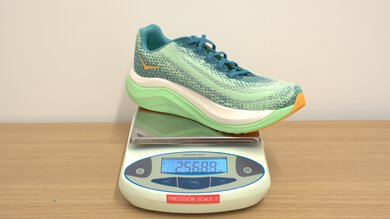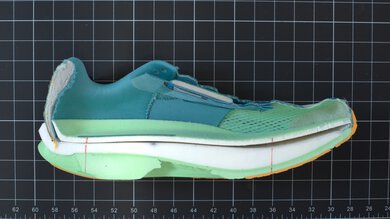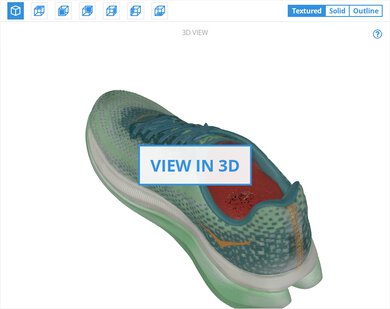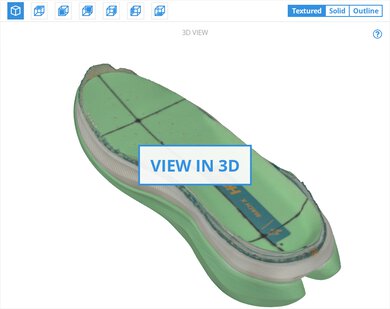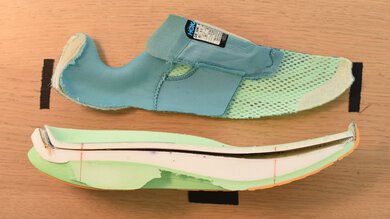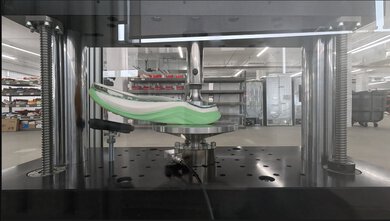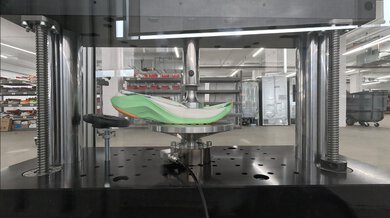The HOKA Mach X is a super trainer that combines good cushioning with a supportive design. It's ideal for runners seeking adaptability across various types of runs. With its dual-layer (EVA and PEBA mix) midsole and integrated plastic plate, this shoe aims to offer a stable feel while keeping things quite versatile, making it an intriguing option for longer, high-tempo intervals as well as easy miles.
Our Verdict
The HOKA Mach X offers decent performance as a marathon racing shoe but doesn't particularly excel. Its cushioning provides a comfortably supportive ride suitable for long distances, but the shoe's weight limits its competitiveness for athletes aiming for peak performance. Its moderate energy return could be sufficient for less competitive marathoners who value comfort and stability over maximal speed and efficiency.
-
Decent energy return.
-
Very stable.
-
Pebax plate.
-
Too heavy.
-
Insufficient energy return.
The HOKA Mach X delivers satisfactory performance for shorter races like 5K and 10K distances. Its firm forefoot contributes to a somewhat snappy feel at quicker paces, but it isn't really lightweight or bouncy, limiting its competitiveness for runners prioritizing speed and top-end responsiveness.
-
Decent energy return.
-
Pebax plate.
-
Too heavy.
-
Insufficient energy return.
The HOKA Mach X offers fair energy return, particularly in the forefoot, thanks to this region's higher concentration of premium PEBA foam. This foam distribution provides a noticeable boost and lively experience, especially benefiting forefoot and midfoot strikers who are more likely to fully engage this area during their stride. Conversely, heel strikers might find it comparatively underwhelming as the heel is much less energetic.
-
PEBA foam placement makes for impressive forefoot energy return.
-
EVA foam placement makes for poor energy return in the heel.
The HOKA Mach X's cushioning is very good, with particularly great impact protection at the forefoot. This makes it suitable for runners seeking plushness for daily training or longer runs. However, it isn't exceptionally plush or luxurious compared to highly cushioned alternatives, mainly due to lower cushioning in the heel.
-
Premium PEBA foam makes for impressive forefoot cushioning.
-
EVA/PEBA mix offers good stability without sacrificing too much cushioning.
-
EVA foam placement makes for lower cushioning in the heel.
The HOKA Mach X delivers very good lateral stability. The wide outsole contributes significantly to a secure and stable ride. Also, the strategic arrangement of foam densities across the midsole ensures dependable firmness and limits lateral movement. This makes this shoe suitable for runners who need reliable support and security, especially during runs involving pace variation.
-
Pebax plate.
-
EVA/PEBA mix offers good stability without sacrificing too much cushioning.
-
High stack.
- 7.0 Marathon Racing
- 7.0 5K/10K Racing
Performance Usages
- 6.8 Energy Return
- 7.8 Cushioning
- 7.9 Lateral Stability
Changelog
- Updated Apr 02, 2025: Converted to Test Bench 0.8.
- Updated Apr 02, 2025: Review published.
Differences Between Sizes And Variants
We tested the HOKA Mach X in men's US size 9, as indicated on the label. The color we tested is Ocean Mist/Lime Glow. This model is available in four colorways for men, including Cerise/Cloudless, Dusk/Cloudless, and Black/Silver, and two colorways for women: Dusk/Illusion and Cerise/Cloudless. Wide versions aren't available for this model. The design section applies only to the exact model we tested, but we expect other size and gender variants to perform similarly.
Compared To Other Running Shoes
The HOKA Mach X is a versatile super trainer aimed at runners seeking a balance between cushioning and stability across various training sessions. It works equally well for daily miles and uptempo workouts. However, while this shoe performs adequately across categories, runners prioritizing maximum cushioning and more versatility across paces might prefer its successor, the HOKA Mach X 2. Other popular plated super trainer options include the Saucony Endorphin Speed 4 and the Brooks Hyperion Max 2.
Within HOKA's lineup, the HOKA Mach X sits above the HOKA Clifton 9, their classic daily workhorse, and the HOKA Mach 6, a lighter daily trainer. There's also the ultra-high stack, ultra-cushioned HOKA Skyward X designed for maximum comfort, and carbon-plated racers like the HOKA Cielo X 2.0, built specifically for race day.
For more options, check out our recommendations for the best running shoes to find the perfect pair.
The HOKA Mach X and the HOKA Mach 6 may share a name but serve distinct purposes. The Mach X is a versatile super trainer offering more cushioning and stability, making it suitable for easy mileage and faster-paced workouts. Meanwhile, the Mach 6 is a lighter and more classic daily trainer.
The HOKA Skyward X and HOKA Mach X are both premium trainers, but they cater to different types of runners. The Skyward X is all about maximum cushioning and underfoot protection, making it a great option for recovery runs or those who prefer an ultra-soft, high-stack experience. However, its towering design doesn't translate into a particularly energetic ride. The Mach X, on the other hand, fits more into the super trainer category. It's significantly lighter, more stable, and delivers a snappier feel underfoot. While both shoes incorporate advanced foam blends, the Mach X offers a more versatile ride that works well for both daily miles and uptempo efforts.
The HOKA Mach X and the HOKA Mach X 2 offer a completely different experience—think of the Mach X 2 as a rare sequel that significantly outshines the original. While the Mach X is a decent super trainer, the Mach X 2 takes things to a whole new level, providing a far more cushioned experience, a higher stack height, and significantly better energy return, all while being nearly 20 grams lighter. This combination makes it the preferred option for almost everyone unless you prioritize stability, in which case the original Mach X still offers a more secure feel.
The adidas Adizero Boston 12 and HOKA Mach X are both super trainers designed to provide support for everyday runs. The adidas offers superior stability. However, it's less cushioned but still heavier, making it feel harsher and less agile. This means the HOKA is more versatile and more comfortable for most runners, especially over longer distances or varied training efforts.
Test Results
This model is heavier than other shoes in its class, including its successor, the HOKA Mach X 2, hindering its potential as a versatile super trainer. While not excessively heavy, shedding a bit of weight would notably enhance its appeal for runners seeking optimal agility and performance, especially at faster paces.
The HOKA Mach X's heel energy return is disappointing due to its predominantly EVA foam composition in this region. This choice results in a dull, rather underwhelming sensation at the heel, lacking the liveliness found in the forefoot. Heel strikers may find this aspect disappointing, as it diminishes the shoe's overall energetic feel.
The HOKA Mach X's forefoot energy return is good, thanks to its strategic use of more responsive PEBA foam placed prominently in this area. This premium material efficiently returns energy, providing a responsive bounce at toe-off. Midfoot and forefoot strikers will find it much easier to fully activate and benefit from the shoe's potential responsiveness.
The heel cushioning provides good comfort and protection, particularly suitable for moderate impacts. It handles heel strikes reasonably well, absorbing a lot of energy compared to most super trainers like the Saucony Endorphin Speed 4. However, it's not overly plush either, so this shoe won't offer maximal comfort on very long runs. Its successor, the HOKA Mach X 2, is way more cushioned at the heel, making it more protective.
The shoe's forefoot is really comfortable and very well-cushioned for high-impact running. Its high absorption across varying forces ensures excellent protection, maintaining comfort and softness throughout each stride. This makes it a reliable choice for runners seeking substantial underfoot comfort in the forefoot region, especially during longer distances or when picking up the pace.
The heel is moderately firm in the shoe, offering good stability at lower impact forces but becoming noticeably softer than other super trainers like the adidas Adizero Boston 12 as forces increase.
The shoe's forefoot is firm, providing stable and supportive performance throughout a wide range of intensities. Although it may seem counterintuitive that the forefoot feels firmer than the heel despite the predominance of softer PEBA foam in this area, this firmness results from the shoe's uniquely positioned plastic plate. By progressively sitting closer to the ground towards the forefoot, the plate effectively stabilizes the softer foam, holding everything together. This also ensures a more dynamic energetic toe-off, particularly benefiting those seeking a balance of stability and responsiveness.
Comments
HOKA Mach X: Main Discussion
Let us know why you want us to review the product here, or encourage others to vote for this product.



